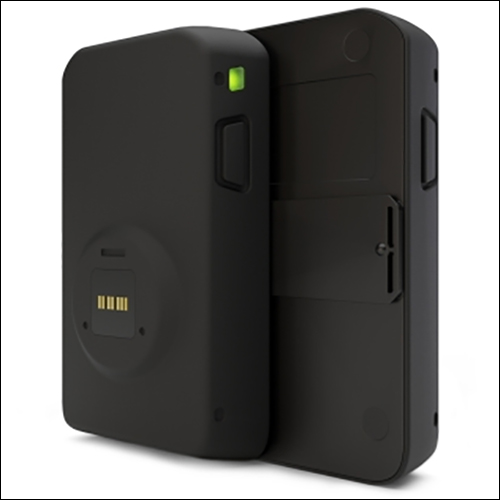Feb 18, 2020Multiple retailers are leveraging a variety of handheld readers to capture item-level RFID tag reads for inventory management in stores. The readers have a relatively long read range and can be easily carried around stores when employees count stock. However, when it comes to serving customers, sales associates are unlikely to have such handheld devices available, so opportunities to benefit from RFID tag reads could thus be missed.
That's the problem solutions provider Infinite Peripherals says it is targeting with its new product, the MaglinQ—a small RFID reader with a built-in 1D and 2D barcode scanner that connects to a smartphone's OtterBox and thereby enables employees to carry the device with them as they help shoppers find the products they seek.
The MaglinQ is designed to connect to the OtterBox uniVERSE case system and thus be attached to a user's smartphone or tablet, in order to enable RFID tag reads at a distance of approximately 18 inches. The device is now undergoing pilots and proofs-of-concept (POCs) as part of the Oracle PartnerNetwork (OPN), for Oracle Retail Xstore's Point of Service solution.
MaglinQ resulted from several changes taking place in the retail market, says Nick Schwarz, Infinite Peripherals' retail director. For one thing, employees are increasingly being encouraged to use their mobile devices to engage with customers, and RFID technology companies are building handheld readers to link read data to those devices. However, Schwarz says, "Retailers want something small, slim and lightweight, but at the same time something that's highly functional. As MaglinQ is a dual-purpose solution, it will help retailers reduce costs, consolidate devices and simplify workflows."
The existing products not only might be relatively large, but are also purpose-built items, such as integrated RFID reader sleds for an Apple iPhone 8 or Samsung Galaxy phone. "As soon as the phone's formfactor changes," Schwarz states, "I, as the retailer, have to consider refreshing our mobile solution sooner than I want to. This is an ongoing frustration for retailers." At the same time, he adds, the retail market's omnichannel evolution is boosting RFID technology use, while barcodes are also in use.
Infinite Peripherals customer Levi Strauss is an example of a brand using RFID and barcode labels, while companies like Lulu Lemon, Nike and Perry Ellis are deploying RFID on some of their product labels. That means stores can benefit from both barcodes and RFID tags if they have the right reading and scanning equipment available.
"There are a ton of RFID readers for cycle-counting today," Schwarz says. These tend to be relatively large, long-range readers. Stores can also benefit from enabling workers to easily access data about a specific product as they serve a customer, without leaving his or her side. MaglinQ is designed to enable employees to better engage with customers, read tags at short-range and thereby access information regarding inventory levels and products, both on and off the sales floor.
The device measures 4.5 inches in height, 2.75 inches in width and 2 inches in thickness, and it weighs 4.7 ounces. It connects with a user's iOS- or Android-based device app via a Bluetooth connection. Typically, stores provide sales associates with such devices. "The retailer will have a technology stack and natively create apps or use commercial apps from a number of different providers," Schwarz explains. A user could then simply download the app in order to manage RFID read or barcode scan data, according to Ahmed Abdallah, Infinite Peripherals' RFID product manager.
Employees typically carry the reader throughout a shift. To help a shopper with a product, a worker could take the reader out of his or her pocket and read the RFID tag (or scan the barcode) of an item of interest, such as a sweater. The app on the associate's phone would then display data about that product, and she or he could share such information with the customer, as well as other sizes and colors that may be available in-store and other accessories that might be appropriate.
In the meantime, as a shopper selects items to purchase, the employee can build a virtual shopping basket, then forward that basket to the point of sale so the customer can have a fast, seamless experience when paying for the selected goods. With the RFID tag read data from the app, an associate might be able to find multiple items that would work well together for that individual, thus expanding what might have been a single-product sale to multiple items.
The MaglinQ comes with a reader module, and the company built its own RFID antenna and worked with Impinj, the technology provider, to tune the module and antenna, which enables the device's small form factor. The relatively short read range not only ensures that stray tag reads are not captured by the associate's device, but it also reduces the reader's power consumption so it can operate throughout a typical work shift or longer. For store cycle counts of inventory, the worker would more likely use a traditional long-range reader.
The MaglinQ is expected to be made commercially available in April 2020, Abdullah says. The product is currently being piloted with Oracle Retail by some retailers, which have asked to remain unnamed. It comes with a software developers kit so that solution providers can build the reader into their own solution as well. The reader's suggested retail price is $699.


